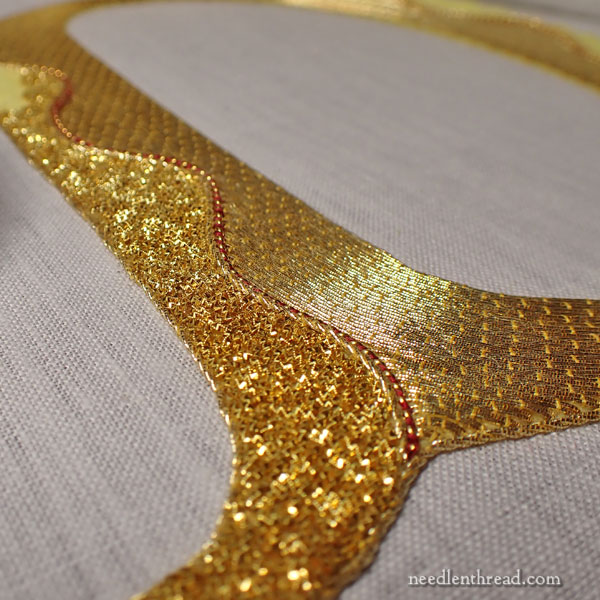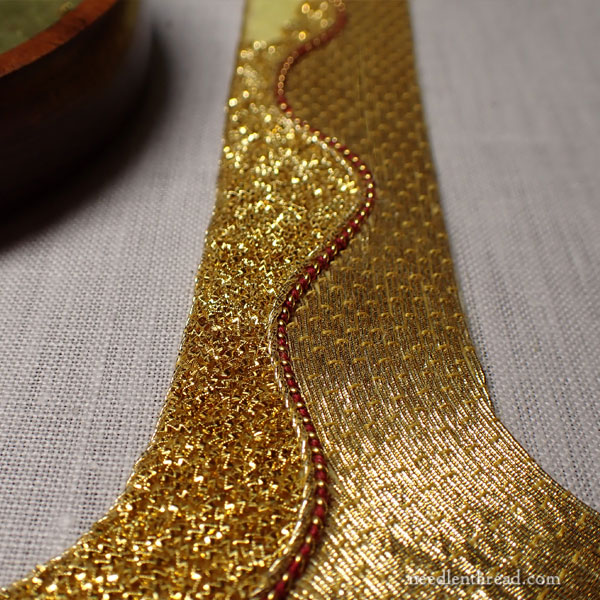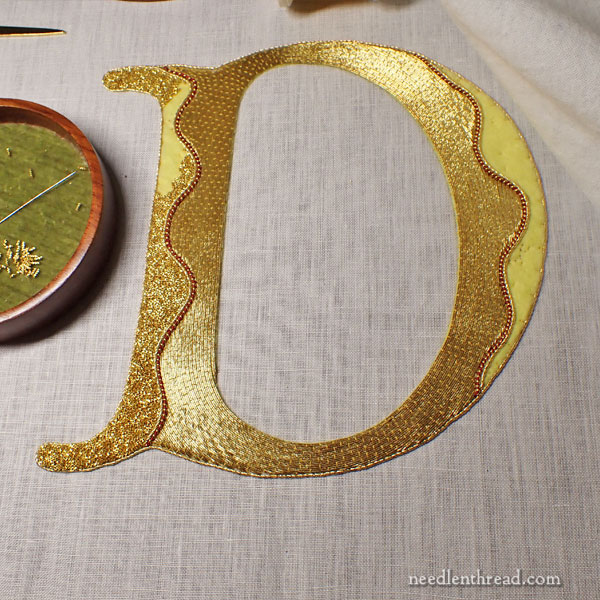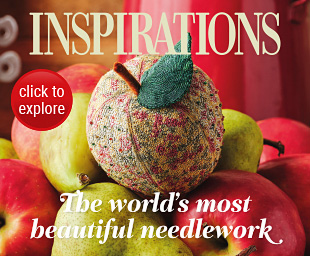Anna sits on her side of the frame.
I sit on my side of the frame.
We’re catty-corner to each other, each hugging the edge of the slate frame and trying to manipulate our arms around the trestles as we embroider letters situated near the edge of the ground fabric.
We work pretty much in silence, except for some soft background music.
And slowly and steadily, we make minute progress on the goldwork lettering that we’ve been working on since last spring.
It’s been a while since we’ve been able to sit and concentrate on embroidery, but at long last, we’re finally able to dedicate specific time to stitching.

With the new year underway and our new work space settled, we are able to divide the work week into various categories: production, manufacturing, and stitch time.
We break each time category down further, according to the tasks that we each undertake. My production time, for example, might be different from Anna’s. I might be writing during production time. She might be packaging or shipping.
If we’re manufacturing, we split up tasks. I might be labeling new twists of thread. She might be making the twists. She might be cutting fabric. I might be transferring designs. Or weighing beads. Or making up kits.
But during stitch time, guess what we’re both doing? You bet!
Our dedicated stitching time happens on two levels: the “extra” level (that’s the goldwork – it’s beyond our normal scope of our work) and the “ordinary” level (the projects directly related to Needle ‘n Thread).
The “extra” involves those projects that we agree to do, whether they are bespoke or voluntary, that we have an obligation to finish by a deadline. It is expedient (especially now, as the deadline on this goldwork nears) that we set aside specific work time during the week to make progress on these projects. We also work outside of work time on them – on the weekends, evenings – whenever either or both of us wants to or can.
The “ordinary” involves those projects that we develop from design to finish, photographing along the way, taking notes and writing instructions, so that we can eventually share them with you through Needle ‘n Thread. This includes the stitch-along projects that show up on the blog as well as specialty designs for kits. This year, we have a few specialty kits lined up to release, and we have a new series of Stitch Snippets for the blog.

On my side of the embroidery frame, I’m working on chip work. This involves cutting tiny pieces of #10 bright check purl – a very fine, spring-like, faceted wired thread – and sewing the little chips on like beads to fill open areas on the letters. You can read about chip work up close in this article from a previous goldwork project.
On her side of the frame, Anna is finishing up the couching work with passing thread, and she’s adding twist and pearl purl wrapped with read silk to the letters. You can read about stretching pearl purl here. It’s one of my favorite techniques!
Eventually, I’ll switch to her side of the frame and she’ll switch to mine, and we’ll go back and forth, dedicating our time to the aspects of goldwork that we each particularly like better or that we’re better at.
Right now, it’s all chip work for me, because Anna is not fond of chip work.
And it’s all plunging and couching and stretching and twisting for her, because… well, because Anna is not fond of chip work.

I like chip work. I like the effect, especially. But I like the randomness of it, too. Anna’s not too fond of Random.
However, I liked chip work Much Better when I had better vision. I find it considerably more difficult with the blind spot in my eye. It’s definitely slower, and I can’t manage it without a magnifier.
My Magnifier Idea
Incidentally, I wish someone would invent an “over the head” magnifier to mount above frames or above a table, so that the magnifier reaches down from above. Picture a bar fixed to two upright side legs. The legs fix to your frame or they stand on your table, and along the bar, you can slide the magnifier, or fix it at intervals, and pull it down from above. It would be much less awkward than a stand magnifier that you have to manipulate over the edge of your frame, and then somehow avoid elbowing every time you move.
Has anyone out there tried anything like that? I’d love to hear!
I wonder if I could rig something with a clamp-on magnifier…
Looking for More Information on this Project?
Well, my friends, we’re making progress on the goldwork! And that’s the whole point of today’s article. I just want you to see that we are actually embroidering in the studio again!
If you’d like to read about this project, you can find the back articles on it under the topic tag “Goldwork” for now. I’ll eventually be making an index for this project, so that you can easily find all the articles for it, arranged chronologically as the project develops. I keep indexes for most projects on Needle ‘n Thread right here, under Tips & Techniques, if you’re ever in the mood for browsing past projects!
Happy Monday!







I am on team Anna. I like the finished look of random stitching. Good seed stitching or check purl is beautiful. But I can’t seem to stitch random beautifully; I always end up with little lines of stitches soldiering along in neat and mostly orderly files. So… I go for more orderly stitching. Silk shading is about as “random” as I can manage, and even there I have to be very careful not to end up with discernable bands of color.
I was thinking I should ply Anna with a little whiskey before she starts, just to see if it loosens up her approach to random. LOL! It could make Studio Life pretty interesting!
I like your comment about the magnifier. I wish there was a magnifier that would enlarge my work like I want it and still have room for my hands. The trouble is that the more magnification you use the closer the lens is to your work, leaving no room for your hands.
Exactly! That is one big drawback of the over-the-work magnifier!
My artistic training is as a scientific illustrator. Try looking for surgical lights or dissecting magnifiers. You can find small ones you can rest on your work or large ones – some have their own lights – that you can clamp onto the sides and adjust.
Thanks, Amanda! I will look them up!
Hi Mary, I love seeing your beautiful gold work. Regarding a magnifier, I’ve used them for color pencil work and find that there’s a pretty small “sweet spot” of magnification clarity. Other artists I know wear magnifying glasses. Have you tried them?
Yes. It seems like I’ve tried everything! But I have another optometrist appointment this week, so maybe we’ll come up with a new solution!
I wish someone would invent a head magnifier for people who have unequal sight. I am nearsighted in the left eye and far sighted in the right eye and no magnifier I have found is totally satisfactory. The reason for this I am told, by my eye doctor, is that the magnifier will distort the image due to my particular condition. And anyway, all lenses are not mixed but the same for left and right. The only one I use is a jeweler’s head magnifier by OptiVisor, 7X. Again, it is not perfect, but with certain tilting of the head depending on the stitch, I can get by. I do surface embroidery only, as a result.
I hear you, Alicia! That’s just it – not all eyes are equal! This is where something like CraftOptics comes in handy. You can read about them here: https://www.needlenthread.com/2019/10/craftoptics-a-discount-for-readers.html
They do work great, because they take your own prescription and work from there to make customized magnifying loupes over glasses for you. Unfortunately, I have a bothersome blind spot that takes up about a quarter of my lower vision in one eye, and it makes it hard to focus through the loupes.
Regarding help with eye sight. For about 10 years now, when I go see my eye doctor, I get prescriptions for 2 pair of glasses. One is regular no line bi-focals for general all time wear. The second pair I call my power glasses. They are lined bi-focals where the top is the regular distance but the bottom is for closer, 6 to 8 inches, with higher magnification. This allows for a larger “sweet spot” of sight. These have allowed me to continue to do small thread tatting, fine stitching, tiny crochet, etc. Contact me if I can help with any more information.
Thanks, Mary! My optometrist and I are in constant cahoots about getting the “right” lenses. Lately, though, nothing seems to work. I can’t seem to get a good sweet spot. I have an appointment at the end of this week, so we shall see!
That is just gorgeous. Congratulations on getting some dedicated stitching time.
Mary, buen día, espero que todo camine según sus planes, hay una lupa aún que no se si sea la que busca, que tiene un brazo, que puede moverse a cualquier lado, creo que son como las que se usan las personas que hacen limpieza faciales, espero que sea lo que busca. Bendecido y productivo día.
Re magnifier – every time I go to the Dentist I covet their Lighted Magnifying eyeglasses. Also that bright directed light that they shine into your mouth. Of course the cost of both are way too high for stitching. Still a nice thought.
CraftOptics makes loupe-style glasses like those used by jewelers and dentists. They are pretty darned effective! Unfortunately, I have a blind spot now right where the focal point is on these types of loupes – I need to find out if they will work or not. I’ll keep trying!
My husband works on antique clocks and definitely needs magnification. He had glasses made for him that are similar to what a dentist uses. The powerful magnifying lenses flip up from the regular lenses, so he can easily switch from regular to close-up vision.
That all looks fabulous! What a LOAD of WORK!!
I agree with you about magnification! While it is useful (and necessary) there is always a hassle-factor getting it “right” — the right angle, to hold steads, to get the arms “out of the way”. There are those extra-powered spectacles with a small mounted light available (sort of like dentists and surgeons use). They are on the expensive side and, from my experience, you actually have a very small “spot” of clarity that you still have to constantly get “right”. Is there no perfect answer???!!!!
Hi, Bobbi – Yes, CraftOptics is a good brand for the loupe-style magnifiers. I’ve written about them numerous times. Unfortunately, I don’t think they’ll work for me anymore, because of the blind spot, but I will reach out to them again and see what they advise. Maybe they will work, but it seems to me that the focal point on them is exactly where my blind spot is. I’ll keep trying!
What about a jewelers lens or something like that?
If you wear glasses clip-on magnifiers work well and you can get different levels of mangnification. If you don’t wear glasses the reading glasses you can get at a dollar store also work. The great thing about both the clip ons and the glasses is they are always in front of your eyes, move with you , and don’t get in the way of the lighting. I really enjoy seeing the progress of the gold work. I have a few gold work kits waiting for me and seeing your work makes me want to start one of my kits. Have to finish something first though.
Oh, goodness, Mary! That’s beautiful!
Sadly, I, too, have to resort to magnification with some (thankfully not all) of my lace making these days. I already wear glasses (mostly for reading), so I use the clip-on magnifiers by Carson. They come in three different strengths, and so far, the weakest ones are working fine for me. They’re available online from various places, but I found them for a good price at my local Cabela’s sporting goods store. If you don’t already wear glasses, maybe you could clip the magnifiers to some clear frames or off-the-shelf reading glasses?
Hi, Sarah – Thanks! I do wear glasses. For some reasons, OTC magnifiers just don’t work for me. Part of the problem is the difference in eyes. But I will keep trying!
Have you tried the head mounted magnifier/light visor? Something like this? https://smile.amazon.com/Magnifying-Illuminated-Headband-Magnifier-Optical/dp/B09WYY86TR/ref=sr_1_26?crid=1JI471EJWIWZ8&keywords=magnifying%2Bvisor%2Bwith%2Blight&qid=1673926139&sprefix=magnifing%2Bvisor%2Caps%2C91&sr=8-26&th=1
My friends swear by them!
Yes, i have a similar set – if not exactly the same. They don’t work so well for me, because my eyesight is remarkably different in each eye.
It must be a relief to be back to normal stitching/production routines after 2 moves in 2 months!
As to the magnifier situation, I wonder if there’d be a way to use a sturdy clothes rail as a start? How to fasten the magnifier (and light?) to it so it stays where you put it AND have it easily adjustable escapes me right now though.
I use a head-mounted magnifier. My dad was a model railroader and he used something similar for fine work, which is where I got the idea. I will try to send a photo later.
My son gave me a rig a couple of Christmases ago. The headband on it did not lock in place to my satisfaction, so I replaced it with the headband from an old one Dad used. I also added some padding for my forehead for added comfort.
The part in front holds lenses of varying magnification strengths and has a light. I often use w/o the light since my Ott lamp is pretty good and the light adds weight to the headband.
This rig works great except my iPhone facial recognition does not know who I am when I wear it!
Hi Mary,
Gorgeous work as always! I have a random question about the little wooden circle you are using to hold chips and needle. It looks like it has a piece of velvet or something similar to keep the chips and beads from rolling around. I’ve seen it show up in some other posts you’ve done where you are beading. Where did you get it, or did you make it?
Thanks!
Bonnie
Hi, Bonnie – that’s a lovely little round wooden tray, velvet lined, with a magnet on the back, from Jenny Adin-Christie in the UK. You can find them here. They come in large and small, and both sizes are great to have. I could use more of them! In the meantime, though, I have also used a small, shallow decorative tin (like the kind you might find available for gift cards and the like at hobby stores and similar places), and lined it with velveteen. You can even buy pieces of velveteen with an adhesive on the back, that you can measure and cut out. The nice thing about a tin is that you can close it when you’re not working.
The one drawback to the velvet lined trays or tins is that there’s usually a slight edge along the inside of the velvet, where chips or beads like to hide. So you do have to occasionally chase them out of the little trough that forms just on the edge.
Hi Mary,
I might have a solution for you magnifier dilemma: “Magnifying Clip On Flip Up Glasses”.
Lots of them available on line, but I had a hard time finding them with zero tint. Most that were labeled “clear” had a yellow tint. The color change drove me nuts flipping back and forth. It might be a non- issue for most folks. My husband doesn’t even notice, he loves them for his coin collecting hobby.
Here are the ones from a company I found that are truly colorless.
https://www.amazon.com/gp/product/B008H4L6RW/ref=ppx_yo_dt_b_search_asin_title?ie=UTF8&psc=1
I’m using mostly the +3.50 version on top my very weak readers (+ 0.75). It’s been a game changer for me! And they don’t break the bank.
I’m curious to find out if you gave it a shot.
Cheers!
Regina
Oops, my bad. For the clip-ons I mostly use +2.0. It depends what I do.
The higher the number the higher the magnification, but my work then needs to be closer to my face. Laws of Optics.
Regina
I have a similar option that Rosemary linked to in one of the comments, but they don’t work well for me. I’ll keep trying, though! Something’s going to work well one of these days – or I’ll figure a way to rig something! 🙂
Hello Mary,
I love Goldwork. I use a magnifying headset when doing fine work. I use the type that sits on your head rather than the magnifying glasses style. I found the glasses too heavy for the bridge of my nose and couldn’t wear them for very long.
The headset comes with a range of magnifying glasses that fit in to the headset. There is also a small, round magnifying glass that you can pull across to really magnify the area on which you are working. The headset also has a very good set of led lights to make the work area even easier to see.
This is the headset I use https://www.amazon.com/Elikliv-Magnifying-Rechargeable-Handsfree-Detachable/dp/B097B5517C/ref=sr_1_7?crid=109SYRW88UQX3&keywords=magnifying+headset+with+light&qid=1673989959&sprefix=magnifying+headset%2Caps%2C397&sr=8-7
I hope this helps.
Regards,
Rosemary
Hi, Rosemary – Thanks for your help! I have a set of those, but they don’t work for me, unfortunately. I have tried and tried them. So far, the one magnifier that works well for me is a 1.75x craft magnifier on a stand, except that the stand gets in the way. I practically have to hug it. This is why I was hoping to find an overhead solution. I think I can rig something – we’ll see what happens!
Hi Mary – a magnifier like dentists use? I eye those things every time I have an appointment but they are definitely out of my price range . Love your goldwork!
I love seeing photos of your goldwork. I don’t have the patience to attempt it–which is kind of a relief, since I do so many other crafts in addition to embroidery. But goldwork is gorgeous!
If you have not tried glasses that are magnified it might be worthwhile. I uses glasses that are 6x and 5x when working on fabric that is fine. You can get them online and they are not expensive. You might get a pair and try them out and if you like them you can get a better quality pair. I believe they are called reading glasses. Good luck finding something that works better for you. Jan
Hi Mary, my father has a magnifier just as you’ve described that can bolt to a frame that he purchased for his electronics work. We live in Australia so I don’t know what’s available in the US but it is essentially the same as my floor standing magnifier. A light with magnifying glass about 20 cm in diameter on an arm that moves up and down and angles all attached to a piece of metal that can be bolted. In Australia I believe it was purchased from either Altronics or Jaycar Electronics.
Hope you can find something similar, I find a lot of the tools for fine electronic work are very similar to my embroidery tools.
Thanks so much, Leanne! I will look this up!
Magnifier. I have tried many freestanding magnifiers and now just go with magnifying reading glasses. These you can raise above for eyes when you don’t need them. It just improves the accuracy and detail of any project.
Instead of a magnifier, I use +400 magnifying glasses. They’re too strong for reading, but great for needle work. I keep them low on my nose, so I can look over them. I never have to reposition them.